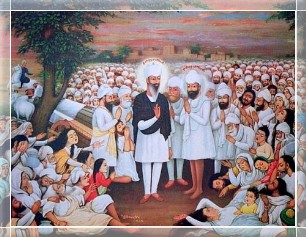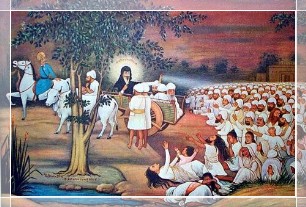namdhari world
Main menu:
- Home Page
- Kuka Faith
- History
- Sikh Gurus
- Namdhari Gurus
- Freedom Fighter - Satguru Ram Singh Ji
- Warrior of Peace
- Non-Cooperation Movement page 1
- Non-Cooperation Movment page 2
- Kuka Postal Service
- No Trial
- Battle for recognition as part of India's struggle for freedom
- Plaque at Ludhiana Railway Station
- Ram Singh Kuka by G.K.Venkateshamurthy
- Social Reforms by Satguru Ram Singh Ji
- Birth of Sant Khalsa
- Kuka Movement - by Film division of Government of India
- KUKA LEHAR - India's first war for independance (1856)
- Satguru Jagjit Singh Ji
- Contradictions
- Historical Quotes
- Vaisakhi - 1699
- Gurmukhi Script
- Sikh Women
- Knowlegde Bank
- Connections
- Places to visit
- Resources
- Music World
- Calendar
- Sports
- ETC...
Satguru Hari Singh Ji continued..
History > Namdhari Gurus
Sri Guru Hari Singh Ji was born in 1819 corresponding to 3rd Narata of Asu, 1876 Bikrami, in the village Raian. His parents were Baba Jassa Singh and Mata Sada Kaur. He was the younger brother of Satguru Ram Singh Ji.At birth he was named Budh Singh. His name was later changed to Hari Singh by Satguru Ram Singh ji. In a Hukumnama send with one of his closest disciple, Shri Darbara Singh, Satguru Ram Singh Ji declared " From now onwards Budh Singh should be called Hari Singh. I vest him with all the spiritual powers to deal with any situation. All the Namdhari Sikhs should follow his command. Even I will honor his decisions. He will keep the flame of Independence burning and spread ideals of Sikhism".
Satguru Hari Singh Ji was entrusted with the responsibility of keeping the Kuka-Sikh movement alive at a time when the British vigil and atrocities against namdhari activities was at its height. Some of the atrocious measures taken by the colonial rulers were:
- A strong 24-hour police post was set up at the main gate of the residence of Satguru Ram Singh Ji.
- The Namdhari Sikhs staying at Sri Bhaini Sahib for the service of Satguru Ji were forced to go back to their respective villages.
- A 24- hour curfew was imposed on the Sikhs. Teams of only five namdhari Sikhs were allowed into Sri Bhaini Sahib at any one time - the second batch was allowed to enter only after the first batch had come out. Hundreds of followers had to spend endless days & nights outside the village boundary despite the severe hardships imposed on them.
- The curfew did not allow the assembly of more than five Namdhari Sikhs, thus, they could neither hold their religious meetings in the public nor communicate with each other.
- Namdharis could leave their villages only after taking permission from the village headman.
The Gurudwara Bhaini Sahib was raided three times by the Government. The site was dug up to sub water level in search for unlawful articles, which the Government believed where buried there.
Satguru Hari Singh Ji was not allowed to leave Bhaini Sahib for 21 years. He had to take prior permission before leaving the station and that too only for specific occasions and for a very short periods, but He kept his religious mission and religious ceremonies on the same status as His predecessor Gurus.
It was three years (after Satguru Ram Singh Ji was deported) before any contact was made with Satguru Ram Singh Ji. Satguru Hari Singh Ji organized and established a regular link between Rangoon and Sri Bhaini Sahib. Namdhari Sikhs made secret missions to Rangoon during which time they brought back many letters (Hukumnamas) from Satguru Ram Singh Ji.
In spite of all these restrictions and hardships, Sri Satguru Hari Singh Ji kept the Political Movement of the Namdhari Sikhs alive and the flame of freedom struggle burning. His teachings accelerated the love for freedom amongst the people and kept the spirit of the fight for Independence alive.

17th January 1872 Satguru Ram Singh Ji is seen at Sri Bhaini Sahib giving instructions to His brother, Bhai Budh Singh, regarding the Kuka Movement. Later while in exile Satguru Ji directed the Budh Singh be known as Satguru Hari Singh Ji

17th January 1872: Pardes gavan - Satguru Ram Singh Ji
Satguru Hari Singh Ji also played a crucial role in the development of Sri Bhaini Sahib. Some of the important works he initiated and carrired out included:
- The development of the Head Quarters at Sri Bhaini Sahib.
- In respect to the langar at Bhaini Sahib:
It was kept open and run efficiently without a break.
More Land was acquired for it.
- Satguru Hari Singh Ji extended free langar at Sri Bhaini Sahib for the famine stricken people during the 1899 famine in Punjab and Bikaner. Satguru Ji fed the hungry people as well as their cattle. More than 6000 famine stricken people were fed daily.
- The commissioner appreciated this act of generosity and wanted to donate 2500 acres of land to Gurudwara Sri Bhaini Sahib for the Langar. Guru Hari Singh Ji refused this offer, and firmly said, "You want to give me only 2500 acres of land and keep the rest of the country for yourself, the whole land belongs to us, and you better leave our country for good."
- While narrating the importance of Langar at Sri Bhaini Sahib, Satguru Hari Singh Ji once went to the extent of saying that he would not mind burning his bones in lieu of wood for the Langar as it is permanent symbol of the Gurus.
- The development of the surroundings of Ram Sar.
- A garden was established and a Kothi for Satguru Ji constructed
- He constructed 'Satguru Ram Singh Mandir' inspite of all the restrictions imposed by the Government.
- Satguru Hari Singh Ji always inspired the people to follow the teachings of the Guru's, e.g.,to take bath from head to heal, recite Gurbani and Chandi-Di-Var, meditate Naam Simran, make a honest living.Serve humanity, fight for the civil rights of the public and fear of the Almighty
- To continue agitation against the cow slaughter
- Satguru Ji always encouraged the depressed hearts of the Namdhari Sikhs and encourage them to remain optimistic about re-appearance of Satguru Ram Singh Ji.
This era saw the emergence of great saints. Many attained perfection after doing naam simran. These included Sant Jeewan Singh Sarhali, Sant Kesar Singh Ji Muhawa, Sant Lal Singh Bhuray Gill, Baba Jawahar Singh Ji Mirzawalia, Sant Narain Singh, Sant Kesar Singh Chup, Sant Kesar Singh Ji Chawinda Sialkot, Sant Heera Singh Ji, Baba Jamit Singh Gill.
Sri Guru Hari Singh Ji initiated 'Akhand Path' of Adi Granth Sahib, inspite of the restrictions imposed by the British Government. The Namdhari Sikhs bore severe hardships very calmly and bravely, Sri Guru Hari Singh Ji completed 101 'Akhand Paths' of Adi Granth Sahib in 1875 and another 101 in 1876. The chain of 'Paths' became the regular feature of the Namdhari Sikhs, innumerable Namdhari Sikhs had to undergo severe punishments and tortures for taking part in these 'Path' recitations and having Religious congregations.
The modem means of communication were non-existent. As such writing about all these realities was a difficult task. Inspite of all this, Sant Santokh Singh rose to the occasion and started writing about the Namdhari movement. He had met Satguru Ram Singh Ji. In the period of Satguru Hari Singh Ji, he was engaged in the service of cows and buffaloes. In his free time, he used to sit with old people and note down the facts as they had seen. This enabled him to complete his book Satguru Bilas covering the period of Satguru Ram Singh Ji and Satguru Hari Singh Ji in details. This however remained as a manuscript only as publishing of any such matter was banned. This book is now under print. Another writer was Sant Dhian Singh who could meet some of the old stalwarts of the time of Satguru Ram Singh Ji and wrote book Satguru Bilas in poetry covering some of the incidents.
Sri Guru Hari Singh Ji had a sweet nature; He was polite, soft spoken, kindhearted person with a very pleasing personality. Satguru Hari Singh Ji always used to help the poor and the needy.
Mata Jeewan Kaur wife of Sri Guru Hari Singh Ji was a very pious and generous lady and helped the suffering humanity in distress. Both Sri Guru Hari Singh Ji and his wife played a very commendable role by serving the people in woe and misery.
There was immense love between Satguru Ram Singh Ji and Satguru Hari Singh Ji. Satguru Hari Singh Ji's days and nights were spent in the sweet memory of his beloved brother. It was very difficult for him to bear the separation; every moment was spent in his sweet remembrance. The heart throbbed and heaved sighs, the eyes rolled in tears. An ocean of love was over brimming, like that of Bharat for Sri Ram Chander Ji. Although Bharat was fortunate enough to meet his brother Sri Ramchander Ji after 14 years, Satguru Hari Singh Ji had to bear the separation of Satguru Ram Singh Ji for 34 years till he left for his heavenly abode June 5, 1906.
Guru Nanak Dev Ji / Guru Angand Dev Ji / Shri Guru Amardas Ji / Shri Guru Ramdas Ji / Shri Guru Arjan Dev Ji / Shri Guru Hargobind Sahib Ji / Shri Guru Har Rai Ji
Shri Guru Har Krishan Ji / Shri Guru Tegh Bahadur Ji / Sri Guru Gobind Singh Ji / Sri Guru Balak Singh Ji / Sri Guru Ram Singh Ji / Sri Guru Hari Singh Ji
Sri Guru Partap Singh Ji / Sri Guru Jagjit Singh Ji